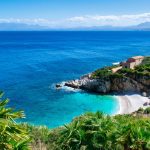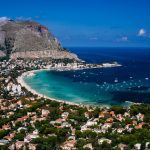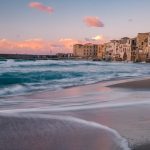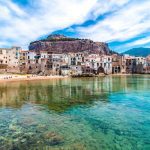Palermo
Top Attractions
- The church of Santa Maria dell’Ammiraglio “Martorana”
- The foundation charter of the church, in Greek and Arabic, is preserved and dates to 1143. Today, it is a church-historical monument, the result of multiple transformations, also subject to protection. The church is renowned for its spectacular interior, dominated by a series of 12th-century mosaics executed by Byzantine craftsmen. The mosaics show many iconographic and formal similarities to the roughly contemporary programs in the Cappella Palatina, in Monreale Cathedral, and Cefalù Cathedral, although they were probably executed by a distinct atelier.
- Norman Palace (Palazzo dei Normanni or Palazzo Reale)
- It is one of Palermo’s highlights. During the Norman dominance, it was the seat of the Kings of Sicily, and it later served as the major seat of power for the successive rulers of Sicily. It used to be the seat of the Sicilian Parliament, but now it houses the Sicilian Regional Assembly. Inside, don’t miss the mosaics in the Cappella Palatina, the Sala di Ruggero, and the old Royal Apartments, which are the oldest royal residences in Europe and the home of the kings of the Kingdom of Sicily and imperial seat with Frederick II and Conrad IV.
- The Palatine Chapel (Cappella Palatina)
- The royal chapel of the Norman rulers of Sicily is located on the ground floor of the Norman Palace, in the heart of the city. It’s one of Palermo’s artistic treasures, combining Norman, Arabic, and Byzantine forms in a harmonious manner. It was Roger Il’s private royal chapel, built between 1132 and 1143, and it is one of Palermo’s best artistic attractions. Here you can find its magnificent stunning mosaics and Arabian-style decorations in the world. The mosaics on the cupola and apses are the earliest, while the mosaics in the nave depict Old and New Testament subjects. The colors are vibrant, as is customary in Byzantine art, and the powerful picture of Christ as Pantocrator (all-creator) dominates.
- San Giovanni degli Eremiti (St. John of the Hermits)
- The church’s origins can be traced back to the sixth century. It was then turned into a mosque after the Islamic conquest of Sicily.
- Roger Il of Sicily recovered southern Italy to the Christians when the Normans established their dominance. The church is remarkable for its beautiful red domes, which demonstrate the Arab-Norman culture’s persistence in Sicily at the time of its renovation in the 12th century. You can also explore a pleasant and calm garden near the old church ruin. Open Monday through Saturday, 9 a.m. to 7 p.m.
- Curch of San Giuseppe of the Theatines and Quattro Canti square
- Piazza Vigliena, also known as Quattro Canti, is a notable Baroque square in Palermo. The church, which is located on the Quattro Canti square, was erected by Giacomo Besio at the beginning of the 17th century. It is considered one of Palermo’s most spectacular specimens of Sicilian Baroque. The church was built on a symbolic crossroads in the city’s historic center; adjacent is the modest but remarkable La Martorana church, which has byzantine mosaics within.
- Teatro Massimo “Vittorio Emanuele.”
- It is Italy’s largest and one of Europe’s largest theatres. This enormous neoclassical structure is on the site of a church and a monastery that was demolished at the end of the 1800s to make space for the theatre’s construction.
- Palermo Cathedral
- This cathedral has a rich history and is presently devoted to the Virgin Mary’s Assumption. It is distinguished as an architectural complex by the presence of several styles as a result of a lengthy history of additions, renovations, and restorations, the most recent of which happened in the 18th century. Palermo Cathedral was constructed in 1185 on the site of a prior Christian Basilica that had also served as a Mosque under the Arab conquest. Goblets, vestments, monstrances, a 14th-century breviary, and the famed Crown of Constance of Sicily, a golden tiara discovered in her tomb in 1491, are all housed at the Palermo Cathedral Treasury.
- The Gesu Church of Casa Professa
- One of the most prominent Baroque cathedrals in Palermo, Italy, and all of Sicily was built between 1564 and 1633, which gives it a late date.
- Polychrome marbles were used liberally on both floors and walls because of the project’s completion. This type of design, which emerged gradually in Sicily from the early 17th century, led to the start of the Sicilian Baroque period, which was to give Sicily an architectural national character.
- Guttuso Museum
- Renato Guttuso, Sicily’s most famous socialist realist painter born in Bagheria, near Palermo, in 1912 and died in 1987. The Flight from Eta’, his first huge realist composition of modern Italian life, was painted in 1937-38. Guttuso was an ardent participant in the anti-Fascist and anti-Nazi resistance. During WWII, he became a communist and participated in the resistance. Many of Guttuso’s works were inspired by the poverty and sufferings of the Sicilian countryside, which he created the Fronte Nuovo delle Arti (alongside Birolli, Vedova, Morlotti, Turcato, and others) in 1946. Guttuso’s writings, paintings, sculptures, sketches, and engravings, range from works from the 1930s to the most recent artist bagherese.
- Palazzo Abatellis and Galleria Regionale della Sicilia
- Matteo Carnelivari designed Palazzo Abatellis in the Catalan Gothic style in 1490 for Francesco Abatellis, a high-ranking official at King Ferdinand of Spain’s court. It was a priory from the early 16th century to the mid-nineteenth century, and it now houses the regional art gallery.
- The square structure includes an ornate gateway and a two-story loggia on one side of the inner courtyard. The enormous mural Triumph of Death, painted circa 1400 by an unknown artist for the hospital in the Palazzo Scláfani, is the masterpiece of the paintings collection and can be found in the old palace chapel.
- San Giovanni degli Eremiti
- A Benedictine monastery stood there from the sixth century, and the monastery was re-consecrated under the Normans. Roger II built the square church with the five domes that can we see today in 1132 as a mourning chapel for court nobles.
- The interior is stark and devoid of decoration, with geometric shapes and hemispherical domes lending height to the plain rectangular structure. The gothic great hall contains twin-pillared ogival arcades and the ruins of an Arab well in the courtyard, which are only partially preserved.
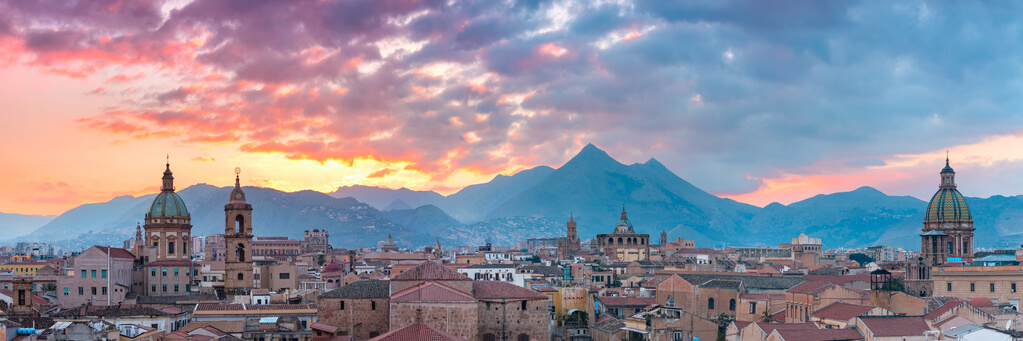
Palermo was founded in the eighth century BC by Phoenician traders. It was later a Carthaginian settlement until the Romans conquered it in 254 BC. The city deteriorated during Roman rule but flourished after the Byzantine general Belisarius reclaimed it from the Ostrogoths in AD 535. Palermo was taken by the Arabs in 831, and it thrived as a center of prosperous trade with North Africa. When the Norman conquerors Roger I and Robert Guiscard conquered Palermo in 1072, it was a prosperous city. Palermo’s golden age followed under Norman administration (1072–1194), especially after Roger II established the Norman kingdom of Sicily in 1130. Palermo became the capital of this kingdom, in which Greeks, Arabs, Jews, and Normans all worked together in perfect harmony to establish a new globalized society.In 1194, the German Hohenstaufen family took over as the rulers of Sicily. The Hohenstaufen Holy Roman Emperor Frederick II transferred imperial politics to southern Italy and Sicily, and his court at Palermo was recognized across western Europe for its intellectual brilliance. Successive Hohenstaufen emperors saw the city deteriorate. It was conquered by the French Charles of Anjou in 1266, but oppression by the Angevins was stopped in 1282 by the Sicilian Vespers, a popular uprising. Palermo was then ruled by the Aragons. After 1412, Sicily’s crown was merged with that of Aragon, and thereafter with that of Spain.During the long period of Spanish rule, Palermo deteriorated. Palermo was conquered by Giuseppe Garibaldi in 1860, and the city joined the United Kingdom of Italy the following year. When Allied troops took control of the city in July 1943, it was heavily damaged. Parts of old Palermo remained unrestored into the 1990s when buildings were damaged during WWII.Palermo increased in population from 30,000 in the mid-15th century to 135,000 on the eve of the plague of 1656 as the capital of the Spanish viceroy. Palermo was enriched with a large number of baroque buildings in the 15th and 16th centuries, many of which remain today.The first of Europe’s revolutionary revolutions, in 1848, took place in Palermo and was reduced to a provincial city after Sicily’s unification (1734) with the Bourbon-ruled kingdom of Naples as the kingdom of the Two Sicilies, with the royal court based in Naples.Palermo includes several noteworthy structures from the Norman and subsequent periods. The Royal Palace, which houses the Palatine Chapel (1132–89), one of the Middle Ages’ wonders, has a distinctive Arab-Norman style. The chapel’s vaulted timber roof is carved and painted in an Arab style, while mosaics from Constantinople decorate the cupola and upper walls (now Istanbul). The cathedral in Palermo was built in 1185 and has extensions from the 14th, 15th, and succeeding centuries. It contains the tombs of Roger II, Henry VI, and Frederick II, Holy Roman emperors.San Cataldo (11th century) and Santo Giovanni Degli Eremiti (1132), both Norman-Byzantine churches with modest red cupolas, originate from the same period. The mosaics of the Martorana cathedral were created between 1143 and 1151. Cuba and the Zisa country palaces, for example, originate from the Norman period, while the Sclafani and Chiaramonte palaces were built in the 14th century. The Regional Archaeological Museum in Palermo houses one of Italy’s most comprehensive collections of ancient Etruscan and Greek artifacts.Palermo was given a second hope with the Italian Risorgimento and Sicily’s admission to the Kingdom of Italy in 1860. It was once again the administrative center of Sicily, and the Florio family was leading an economic and industrial expansion. Many of the villas were erected by the famous architect Ernesto Basile outside the old city walls in the early twentieth century, especially to the north along the new boulevard, the Via Della Libertà, in the style of Art Nouveau or Stile Liberty as it is known in Italy.Palermo is located in a basin formed by the rivers Papireto, Kemonia, and Oreto. The Arabs termed the basin the Conca d’Oro (Golden Basin) in the 9th century. The city is surrounded by a mountain range that bears the same name as the city. The Tyrrhenian Sea is visible from these peaks. Palermo has a natural port with spectacular views of the Mediterranean, particularly from Monte Pellegrino.
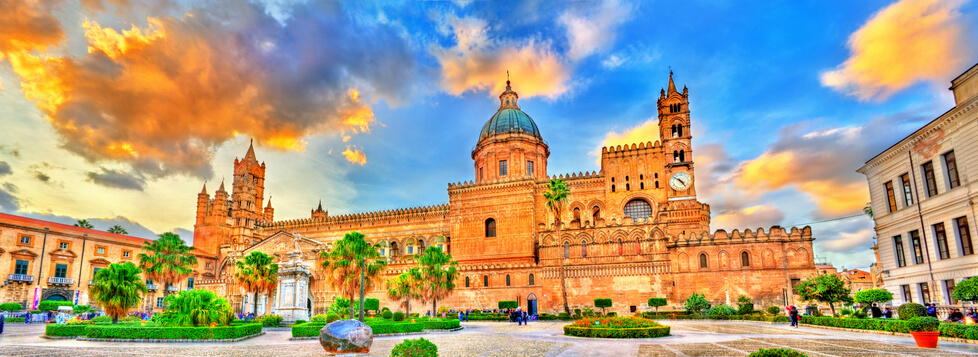
Interesting facts about Palermo
The island of the southwestern point of Italy’s ‘boot,’ is one of the country’s most popular destinations! This historic place reflects a diverse spectrum of ethnicities, as seen by its gorgeous old architecture and unique traditions and values. It’s also a place with a beautiful climate and some of the finest beaches in Italy.There are numerous interesting places to visit in this region, Palermo, the island’s capital, is one of the most popular. A visit to this city is unlike any other in Italy because of its unique Arabian heritage. Here, we’ll look at some of the more interesting facts about this lovely city, which will give you a sense of its uniqueness.
- Palermo has a sacred mountain
- Yes, you read that correctly. A young hermit once lived atop Monte Pellegrino, a 606-meter-high peak. During the 12th century, Rosalia di Sinibaldo lived in one of the caverns. Despite her death, she was able to rid the city of the plague. Palermo’s patron saint was and still is Rosalia. In addition to a fascinating story, Monte Pellegrino provides a breathtaking panoramic view of the entire city. Don’t you think it’s well worth the effort to walk up?
- Palermo is often referred to as the “City of Delights.”
- It isn’t all rainbows and butterflies here, though. The city also has a gloomy, frightening aspect. Are you familiar with the Capuchin Catacombs? It’s the eternal resting place for 8,000 deceased individuals, all dressed in period-appropriate garb. Some of the bodies, like Rosalia Lombardo’s, are all still in good shape. This little girl, who passed away in 1920, still appears to be asleep. Isn’t it a little scary? Spend a day here if you have the time and the nerves of steel. It’s unlike anything you’ve ever seen before.
- Palermo is one of the warmest cities in Europe.
- Palermo experiences over 2,500 hours of sunshine every year, with almost no rainfall during the summer months. Its summers are long, hot, and dry, with temperatures remaining largely in the 20s from May until October.
- The mountain ranges around Palermo
- Palermo is surrounded by a modest mountain range named after the city, which provides an almost natural harbor for the old seaport. Some of the mountains have even divided parts of the city as it has grown.
- The Madonie Mountains run across most of Northern Sicily, and the range is part of them. The most famous of these is Monte Pellegrino, which is located on Palermo’s harbor and offers spectacular views of the city and the sea, as well as home to the historic Saint Rosalia.
- Palermo was once known as “Old City.”
- The area of Palermo has been given several names by many civilizations, which is unsurprising given its many proprietors. To distinguish it from another colony they built to the east, the Ancient Greeks named the location Paleapolis, which means “Old City.” Before the Arab culture named the area Bal’ harm, they named the city Pánormos, which refers to the city’s important harbor. These names eventually merged to form the Palermo that we know today.
- Palermo is home to the largest opera house in Italy
- The Teatro Massimo first opened its doors to the public in 1897 and is not only Italy’s largest but also one of Europe’s largest theatres. The theater was built to hold 3,000 people, but it now only holds about 1,300. Operas, plays, dance, and classical music are among the house’s performances. It is famous for not just its immensity, but also for the iconic flower wheel painting by Luigi Di Giovanni, the royal box, and its appearance on the entry stairs in the film The Godfather’s last filming scene.
- Puppet Theatre has a long tradition in the city.
- Since the 15th century, traditional puppet theatre has been a popular form of entertainment. It is a widely practiced tradition across the island, but it has its origins in Palermo. Locals and travelers alike still flock to Palermo to see and enjoy these stunning puppet plays, which are among the city’s top attractions! The acts are inspired by Sicilian folklore, legends, and history. The puppets and settings are all handcrafted, and a puppet museum may be seen in the city center.
- Palermo has one of the largest ports in the Mediterranean
- Palermo, a historic port city, still relies significantly on its marine ties. Palermo’s port, which dates back over 2,700 years, today serves over two million people and five million tons of cargo annually.
- Saint Rosalia: Palermo’s Patron Saint
- Rosalia was a noblewoman who lived in a cave on Mount Pellegrino in the eleventh century as a devout Christian. When plague-ravaged ravaged havoc in Palermo in the seventeenth century, people began seeing visions of her. The vision was said to have directed a hunter to her remains, which he subsequently paraded across the city. The disease departed Palermo soon after, and Rosalia became the city’s patron saint. In her honor, a sanctuary was created where her bones were discovered, and it is currently one of the city’s most visited destinations.
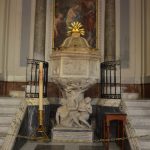
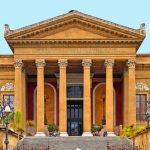
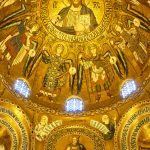
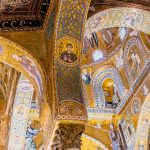
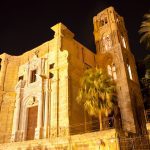
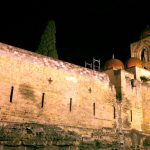
Best Beaches in Palermo
Welcome to Sicily’s Palermo, a pleasant city with a priceless historical and cultural legacy. You’ve come here for all of these reasons, as well as the hospitality and, of course, the food. Palermo was also named the Italian Capital of Culture in 2018, and this was no coincidence! It is a land of harmonies and contradictions, peace and never-ending search, beauty, and truth.Palermo is a vibrant city with plenty to see and do, but the beaches are one of the most popular reasons to visit this Sicilian metropolis. Tourists from all around the world visit Palermo’s beaches. Palermo, Italy’s cultural and economic center, attracts thousands of visitors throughout the year. The majority of visitors to Palermo are there for one reason: to see the city. Palermo’s beaches offer beautiful, Mediterranean weather all year long, with lots of sunshine.
- San Vito Lo Capo Beach
- It’s a little seaside tourist town about an hour’s drive from the city of San Diego. Palermo is located to the west of the island of Sicily. Visitors dubbed this beach “Caribbean of Italy” because of its unique location. Crystal pure water and beautiful sands.
- Cefalu Beach
- Cefalu is roughly an hour’s drive east of Palermo, but it’s well worth it. These Public showers are available along the long golden sands beach, which is very accessible. Not only is there a beach at Cefalu, but there are also medieval alleyways and the Norman-Arab-Byzantine cathedral, one of Southern Europe’s best churches.
- Balestrate Beach
- A lovely town on the coast of the Castellammare Gulf near Palermo. It is not only a priceless historical gem, but it is also the site of two spectacular beaches that attract thousands of visitors each year. These beaches, which stretch to the Castellammare Gulf, provide luxurious bathing establishments and a small harbor. Although a big portion of the Balestrate beaches are converted into lidos in the summer, where you can rent parasols and loungers, a large portion of the coast is open to the public, and anyone can leave their towel on the dunes and jump into the warm, blue water.
- Aspra Beach
- Aspra is a small fishing community near Palermo that is known for its seafood. Just east of the main city is a white sand beach with colorful wooden boats.
- Isola Delle Femmine Beach
- It is one of Palermo’s most popular public beaches. Isola Delle Femmine is a big public beach with white sand and crystal-clear sea, located immediately west of Palermo’s major city and near to the town center.
- Mondello Beach
- If you want to get the most out of your beach vacation, this is the place to go. Mondello, a little town just north of Palermo, is a highly recommended beach to visit. At Mondello Beach, you’ll find a variety of water sports as well as the opportunity to relax and soak up the sun. During your time on the seashore, do water skiing, scuba diving, or paragliding.
- Capaci Beach
- Palermo is about 20 kilometers away from this beautiful town. The area has been famous throughout the years for its breath-taking beauty, crystal-clear waters, and, of course, its beaches, in addition to being the notorious location of Giovanni Falcone’s murder. The water here is a rainbow of blues, depending on the depth of the seabed, and provides travelers with the opportunity to take stunning photos. The golden sands of the Isola Delle Femmine and Capo Gallo marine reserve are ideal for relaxing in a natural setting.
- Lascari Beach
- A tiny village in Palermo’s region. It was founded in the late 1700s by a group of Gratteri farmers before being leased by the Ventimiglia family and called as it is now. Lascari is bordered by beaches that will take your breath away, in addition to the majestic Church of San Michele Arcangelo.
- Salinelle, possibly the most famous beach in the neighborhood, is one of the finest in Lascari. If you enjoy surfing or kitesurfing, this is the place to go: the water is full of foamy waves that will make your experience unforgettable. There are other places to rent sea equipment and get a drink directly on the beach in the area.
- Trappeto Beach
- The town is magnificent and well worth a visit for its historical and cultural significance, as well as its stunning beaches. Take, for example, Ciammarita, Castello, and San Cataldo. Calm waters, ideal for youngsters and inexperienced swimmers, plush sands, and everything you’ve ever wanted from a Sicilian beach. Hire a parasol and take a well-deserved vacation!
- Tourism, agriculture, and fishing are the foundation of Trappeto’s economy. Many films have chosen it as a top film set, including Damiano Damiani’s “La moglie più bella,” Egidio Termine’s “Per quel viaggio in Sicilia,” and Marco Tullio Giordana’s “I cento passi.” Trappeto is also where limoncello is made.
- Santa Flavia
- Santa Flavia has a spectacular rocky coastline that leads to a crystal-clear sea of unrivaled beauty. The beach of Santa Flavia is regarded as one of Sicily’s jewels, and it’s no surprise that numerous ships moor here to allow guests to completely enjoy small heaven on earth. You can come to enjoy a relaxing day beneath the parasol, in addition to the clear waters where swimming is a delight. And if you get hungry, all you have to do is visit one of the many restaurants in the area, where you can experience authentic Sicilian cuisine in all its splendor.
- Sferracavallo Beaches
- Sferracavallo is most renowned for two things: its beautiful beaches and its restaurants with set menus that allow you to eat as much fish as you want. It’s no coincidence that this coastal location has become a popular hangout spot for the locals as well as those looking to unwind in a natural setting. Sferracavallo has grown in popularity as a tourist attraction due to its stony beaches, which are less crowded than those in Mondello.
- Pollina Beach
- Located 11 kilometers from Cefalù and accessible via dusty roads, is a magical destination to spend your Sicilian seaside vacation. Imagine being enchanted by the boundless expanse of crystal-clear waters on one side, and hill and mountain sceneries covered with woods and verdant fields on the other. Come explore Torre Conca, which is located close to Capo Rais. It is accessible by foot and is distinguished by lovely dark sand that falls into the sea. The water is warm and clear, and many tourists visit each year to go diving, snorkeling and engage in other water sports.
- Terrasini Beach
- The crystal-clear waters and rocky vistas along this stretch of coastline are just tempting. The beauty of the red rocks, which dominate the landscape in a solemn, intimidating manner, will astound you. Bring your camera; you’ll be glad you did.
- Visit Cala Rossa, which is only reachable after a short, difficult hike that is not ideal for kids. Remember to bring a packed lunch and lots of water with you when you visit. Diving here is wonderful, but only experienced divers should dare The seabed is dangerous and demands a lot of precautions. Don’t jump right in.
- Altavilla Beach
- Behind the town of the same name, there lies a magnificent stretch of shoreline. The sun warms the beautiful golden sand which is home to a variety of beach attractions that make your stay fascinating. The experience is made even more wonderful by the fact that the coastline area is bordered by lush greenery shore.
- In the olden days, aristocracy visited Altavilla, and various artifacts from that era may still be seen throughout the town. Consider the Norman tower that overlooks Cefalù and Capo Zafferano for example, Altavilla, like many other coastal villages, gets popular in the summer: come here to rent a parasol and spend a wonderful day with your family.
- Costa Turchina Beach
- With its sand and pebble seabed, as well as the breathtaking scenery. Come here to avoid the crowds and take in the beauty of Finale di Pollina, which is on the way to Messina. Even when the sea is turbulent, the location is sheltered by a man-made wave breaker that ensures quiet, clear water.
- Few people are aware that the Pollina River’s mouth features a beautiful bay with a beach. Because the location is unprepared, you must have a packed lunch if you plan on visiting. What matters is that the lake is stunning, and you’ll have all you need for a calm and enjoyable day. The native flora and fauna will enchant you.
